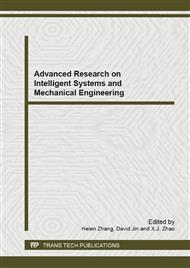p.123
p.129
p.137
p.141
p.145
p.151
p.157
p.161
p.165
Influence of Microstructures on Wettability on Stainless Steel
Abstract:
The influence of microstructures on wettability on stainless steel was investigated. Two kinds of different microstructures were manufactured by a laser processing method with micro parallel grating and square pillars array. The experimental and theoretical values of contact angle (CA) were obtained. Furthermore, within the groove spacing processing size range in micron scale, the experimental results agreed with the theoretical predictions based on the Wenzel. By the influence of machining and measuring conditions, the experimental values of CA were smaller than the predicted theoretical values. A linear relationship between the CA and the micro-scale structures was obtained, which showed the CA was increased with an increase of groove spacing. With the same structural parameters, the CA of square pillars array microstructures was larger than parallel grating microstructures.
Info:
Periodical:
Pages:
145-150
Citation:
Online since:
January 2013
Authors:
Keywords:
Price:
Сopyright:
© 2013 Trans Tech Publications Ltd. All Rights Reserved
Share:
Citation:


